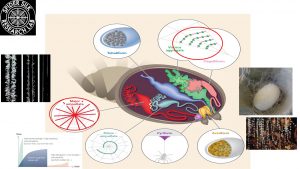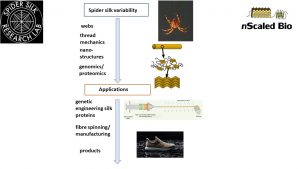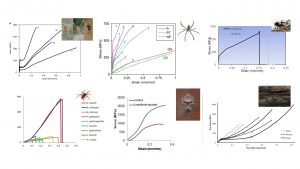Uruguay Lectures – Chinese Congress, Aachen, King’s College presentations Pt1
Between December 10 2022 and January 17 2023 I presented three talks/seminars: to the 10th China International Silk Conference (Dec. 10), then to RWTH Aachen University in Aachen Germany (Jan 10), then to King’s College London (Jan 17). As the contents across the presentations were similar and broadly covered the activities of the Spider Silk Research Lab over the past 8 to 10 years, I can give here a general overview of them here with reference to my preparation notes. Here goes:
Silk Types examined
At the Spider Silk Research Lab, we are primarily interested in spider silk, and more specifically dragline or major ampullate silk (highlighted red in the image below below). This is because it is the silk considered to be tougher than Kevlar and gram-for-gram stronger than steel. The lab examines other silks, however, including the gluey aggregate silks of orb weaving spiders, the wooly adhesive silk of cribellate spiders, silkworm silk, and the sticky silks of glowworms (see image). We’ve also commenced a program to investigate the silks of bagworms (i.e moths from the Family Psychidae, which I introduce in ‘Silk: Exploring Nature’s Superfibre’).

Research Program
As depicted in the image below, the lab has specialized over the years in doing pure research programs on spider silk variability. We have been interested in understanding this variability at the whole web, individual silk thread, protein structure and gene level, and have a track record now of publications across all of these. Moving forward, we are looking to branch into, on the back of our silk genome work, the generation of recombinant silk proteins and spinning these into functional fibres. I have also initiated collaborations (such as that with Trish Flanagan at UNSW Art & Design among others) to build wearable and other products out of these fibres.

Testing webs and threads
I have been testing the properties of spider webs and individual silks for over 10 years. To test individual thread mechanics I pull a single thread directly from the spinnerets of the spider across a carboard strip with 10 x 10 mm frames cut out along it using a mechanical spool. This allows me to glue the silk to the cardboard at the frame borders and cut between the frames to end up with a series of individual carboard frames, each with a silk thread across it. The frames are mounted onto a tensile tester, such as the Agilent T150 housed at the Institute for Frontier Materials at Deakin University, and the thread pulled until it ruptures.
By using this method we have stress-strain curves of many different spiders including: (i) different species from around Sydney, (ii) single species of spider (e.g. Nephila pilipes in Taiwan) when fed on diets that differ in prey type or in nutrients taken up, (iii) native (to Australia) and invasive (to Uruguay) house spiders, (iv) a range of web building and fossorial foraging wolf spiders, (v) Parawixia spiders in Uruguay that have been exposed to insecticides, and (iv) Hickmania cave spiders from Tasmania of a range of different sizes, thus different ages. What these various studies have shown us is that spider dragline and other silks are highly variable and differ in a range of properties depending on a wide variety of factors.

To gain a better understanding breadth of the variability in properties in dragline silk, and their drivers, I have teamed up with Jose Perez-Rigueiro and others at the Universidad Politécnica de Madrid in Spain to develop and compare a standardization parameter that the group in Madrid has identified to correlate strongly with the ability of any single thread to shrink when exposed to water, a phenomena called supercontraction. We accordingly have recently published a paper tracking this parameter (called α*) across several species of spiders from many Families. It seems the parameter has evolved over time (being lower in derived spiders and higher in more ancestral spiders) and probably correlates with the types of proteins the spiders express in their silk (our paper is published at The Spider Silk Standardization Initiative (S3I): A powerful tool to harness biological variability and to systematize the characterization of major ampullate silk fibers spun by spiders from suburban Sydney, Australia – ScienceDirect).
More to come in future posts….

